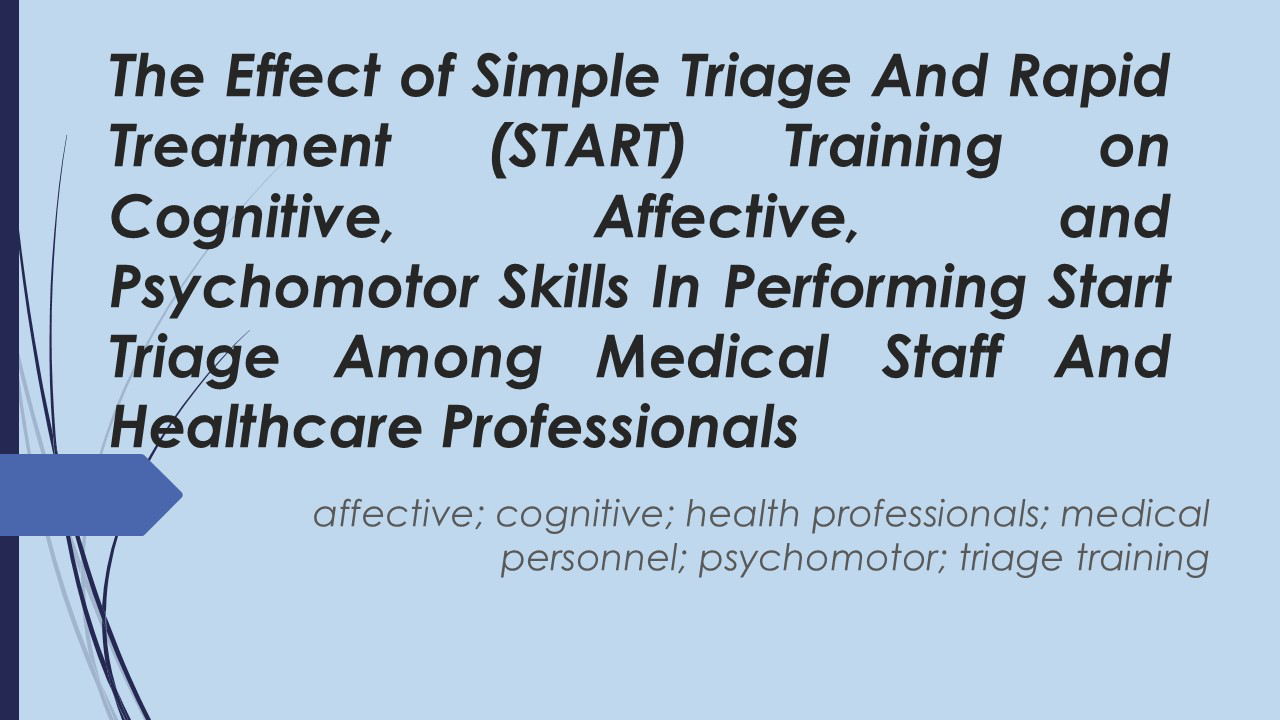The Effect of Simple Triage and Rapid Treatment (START) Training on Cognitive, Affective, and Psychomotor Skills in Performing START Triage Among Medical Staff and Healthcare Professionals
DOI:
https://doi.org/10.23917/bik.v18i2.9861Keywords:
affective, cognitive, medical personnel, psychomotor, Triage trainingAbstract
The increasing incidence of disasters globally underscores the importance of preparedness to minimize errors during disaster triage. Inadequate triage can elevate mortality and disability rates. The commonly used and easily applicable triage system is known as the START method. Currently, there is no effective training available for medical and healthcare professionals to enhance cognitive, affective, and psychomotor skills in the context of disaster triage. This study aims to understand the significance of Simple Triage and Rapid Treatment (START) training on cognitive, affective, and psychomotor skills in performing START triage among Medical and Healthcare Professionals at Cangkringan, Pakem, and Turi Health Centers. The research design employed in this study is a quasi-experiment utilizing a pre- and post-test without a control group design. The respondents for this study are medical and healthcare professionals at Puskesmas Cangkringan, Pakem, and Turi, totaling 43 individuals. The intervention applied involves providing START triage training conducted over one day. Both pre-test and post-test assessments are carried out on the same day, with the post-test immediately following the completion of the training. While this approach may not fully capture long-term knowledge, attitude, and skill improvements, it is useful for assessing the direct impact of the training. Data collection involves the use of cognitive and affective questionnaires, along with a psychomotor observation sheet. The data analysis is conducted using a paired t-test. There is an increase in the average scores for cognitive (57.21 vs. 78.60), affective (33.56 vs. 36.35), and psychomotor (18.98 vs. 23.02) aspects before and after the training. The training in Simple Triage and Rapid Treatment has a significant influence on the cognitive (p < 0.001), affective (p < 0.001), and psychomotor (p < 0.001) skills of medical and healthcare professionals in performing START triage. The START training is crucial and should be conducted in every community health center (puskesmas) to enhance the competence of medical and healthcare professionals in performing START triage.
Downloads
References
Aji, L. J., Sumantri, S. H., Subiakto, Y., & Rahmawati, A. (2022). Destana-Based Disaster Risk Reduction in Glagaharjo Village in Realizing Regional Resilience in Sleman Regency. Jurnal Manajemen Bencana (JMB), 8(1), 101–118. https://doi.org/10.33172/jmb.v8i1.1207
Almeland, S. K., Depoortere, E., Jennes, S., Sjöberg, F., Lozano Basanta, J. A., Zanatta, S., Alexandru, C., Martinez-Mendez, J. R., van der Vlies, C. H., Hughes, A., Barret, J. P., Moiemen, N., & Leclerc, T. (2022). Burn mass casualty incidents in Europe: A European response plan within the European Union Civil Protection Mechanism. Burns, 48(8), 1794–1804. https://doi.org/https://doi.org/10.1016/j.burns.2022.07.008
Anderson, L. W., & Krathwohl, D. R. (2001). A Taxonomy for Learning, Teaching, and Assessing: A Revision of Bloom’s Taxonomy of Educational Objectives. In Longman.
Astuti, Z., Milkhatun, M., & Latipah, A. J. (2022). Web-Based Triage Game Application Development as A Disaster Triage Learning Tools During The Covid-19 Pandemic for Nursing Students. Indonesian Nursing Journal of Education and Clinic (Injec), 7(1), 53. https://doi.org/10.24990/injec. v7i1.452
Bazyar, J., Farrokhi, M., Salari, A., & Khankeh, H. R. (2020). The Principles of Triage in Emergencies and Disasters: A Systematic Review. Prehospital and Disaster Medicine, 35(3), 305–313. https://doi.org/10.1017/S1049023X20000291
Bijani, M., & Khaleghi, A. A. (2019). Challenges and Barriers Affecting the Quality of Triage in Emergency Departments: A Qualitative Study. Galen Medical Journal, 8. https://doi.org/10.31661/gmj.v8i0.1619
BNPB. (2022). Rangkuman bencana tahun 2022.https://gis.bnpb.go.id/ arcgis/apps/sites/#/public/pages/bencana-besar-tahun-2022
Chumvanichaya, K., Yuksen, C., Nuanprom, P., & Aramvanitch, K. (2025). A comparison of SIEVE, SORT, and START triage training effectiveness between immersive interactive 3D learning materials using virtual reality (VR-SSST) and traditional methods in mass casualty incidents. International Journal of Emergency Medicine, 18(1). https://doi.org/10.1186/s12245-025-00850-2
Cone, D. C., Serra, J., & Kurland, L. (2011). Comparison of the SALT and Smart triage systems using a virtual reality simulator with paramedic students. European Journal of Emergency Medicine, 18(6), 314–321. https://doi.org/10.1097/MEJ.0b013e328345d6fd
Connor, E. O., Gatien, M., Weir, C., & Calder, L. (2014). Evaluating the effect of emergency department crowding on triage destination. International Journal of Emergency Medicine, 7(16), 1–7. https://doi.org/10.1186/1865-1380-7-16
Creswell, J. W., & Creswell, J. D. (2018). Research Design: Qualitative, Quantitative, and Mixed Methods Approaches (5th ed.). SAGE Publications.
Ericsson, K. A. (2008). Deliberate practice and acquisition of expert performance: A general overview. Academic Emergency Medicine, 15(11), 988–994. https://doi.org/10.1111/j.1553-2712.2008.00227.x
Goniewicz, K., Goniewicz, M., Włoszczak-Szubzda, A., Burkle, F. M., Hertelendy, A. J., Al-Wathinani, A., Molloy, M. S., & Khorram-Manesh, A. (2021). The importance of pre-training gap analyses and the identification of competencies and skill requirements of medical personnel for mass casualty incidents and disaster training. BMC Public Health, 21(1), 114. https://doi.org/10.1186/s12889-021-10165-5
Green, A., & Hug, M. (2020). Simulation Training and Skill Assessment in EMS. StatPearls, StatPearls Publishing. http://www.ncbi.nlm.nih.gov/pubmed/32809397
Hamdi, A., & Al Thobaity, A. (2023). Enhancing Disaster Triage Competencies through Simulation-Based Training: An Interventional Study among Undergraduate Nursing Students. Sustainability (Switzerland), 15(21). https://doi.org/10.3390/su152115513
IRBI. (2016). Indonesia Disaster Prone Index 2016. Available at: http://kawasan.bappenas.go.id/images/data/Kegiatan/ Berita/ 14122016 /Penurunan_IRBI_Indonesia.pdf
Kirkpatrick, & Kirkpatrick, J. D. (2006). Evaluating Training Programs: The Four Levels. In Berrett-Koehler Publishers. Berrett-Koehler PublisherS.
Kolb, D. A. (1984). Experiential Learning: Experience as The Source of Learning and Development. Prentice Hall, Inc., 1984, 20–38. https://doi.org/10.1016/B978-0-7506-7223-8.50017-4
Krathwohl, D., Bloom, B., & Masia, B. (1964). Taxonomy of educational objectives: The classification of educational goals - Handbook II: Affective Domain. Studies in Philisophy and Education, 164–170.
Kurniyanti, M. A. (2012). The Role of Health Workers in Disaster Management (Disaster Management). Jurnal Ilmiah Kesehatan Media Husada, 1(1), 85–92. https://doi.org/10.33475/jikmh.v1i1.87
Lampi, M., Junker, J. P. E., Tabu, J. S., Berggren, P., Jonson, C. O., & Wladis, A. (2018). Potential benefits of triage for the trauma patient in a Kenyan emergency department. BMC Emergency Medicine, 18(1), 1–7. https://doi.org/10.1186/s12873-018-0200-7
Melnikov, S., Itzhaki, M., & Kagan, I. (2014). Israeli Nurses’ intention to report for work in an emergency or disaster. Journal of Nursing Scholarship, 46(2), 134–142. https://doi.org/10.1111/jnu.12056
Nafiati, D. A. (2021). Bloom's taxonomy revision: Cognitive, affective, and psychomotor. Humanika, 21(2), 151–172. https://doi.org/10.21831/hum.v21i2.29252
Noe, R. (2017). Employee training and development. NY: McGraw Hill Education.
Noh, J., Oh, E. G., Kim, S. S., Jang, Y. S., Chung, H. S., & Lee, O. (2018). International nursing: Needs assessment for training in disaster preparedness for hospital nurses a modified delphi study. Nursing Administration Quarterly, 42(4), 373–383. https://doi.org/10.1097/NAQ.0000000000000309
OHCA. (2022). Global Natural Disaster Assessment Report. UN Annual Report, October, 1–80. https://reliefweb.int/report/world/2021-global-natural-disaster-assessment-report
Pesiridis, T., Sourtzi, P., Galanis, P., & Kalokairinou, A. (2015). Development, implementation and evaluation of a disaster training programme for nurses: A Switching Replications randomized controlled trial. Nurse Education in Practice, 15(1), 63–67. https://doi.org/10.1016/j.nepr.2014.02.001
Schunk, D. H. (2012). Learning Theories: An Educational Perspective. In Pearson Education.
Simpson, E. J. (1971). Educational objectives in the psychomotor domain. Behavioral Objectives in Curriculum Development: Selected Readings and Bibliography, 60(2), 1–35. https://files.eric.ed.gov/fulltext/ED010368.pdf
Taryudi, T. (2021). Formation of First Responder (FR) Based on Internet of Things as an Effort to Increase the Capacity of Health Workers for Disaster Emergencies in the Tangerang Health Center Work Area, Banten. Jurnal Abdimas BSI: Jurnal Pengabdian Kepada Masyarakat, 4(2), 174–180. https://doi.org/10.31294/jabdimas.v4i2.9188
Tevis, S. E., Patel, H., Singh, S., Ehrenfeucht, C., Little, C., Kutner, J., & Persoff, J. (2022). Impact of a Physician Clinical Support Supervisor in Supporting Patients and Families, Staff, and the Health-Care System During the COVID-19 Pandemic. Disaster Medicine and Public Health Preparedness, 16(1), 328–332. https://doi.org/10.1017/dmp.2020.345
Wang, Z. Y., Zhang, L. J., Liu, Y. H., Jiang, W. X., Jia, J. Y., Tang, S. L., & Liu, X. Y. (2021). The effectiveness of E-learning in continuing medical education for tuberculosis health workers: a quasi-experiment from China. Infectious Diseases of Poverty, 10(1), 1–11. https://doi.org/10.1186/s40249-021-00855-y
Widayatun, & Fatoni, Z. (2013). The Role of Health Workers and Community Participation in Health Issues In A Disaster Situation : The Role Of Health Personnel and Community Participation. Jurnal Kependudukan Indonesia, 8(1). https://doi.org/1907-2902
World Health Organization. (2005). Emergency Triage Assessment and Treatment (ETAT): Manual for Participants. Switzerland: WHO Press, 78

Downloads
Submitted
Accepted
Published
How to Cite
Issue
Section
License
Copyright (c) 2025 Novia Faizatiwahida, Bagus Alfrisa, Intansari Nurjannah, Syahirul Alim

This work is licensed under a Creative Commons Attribution 4.0 International License.


















